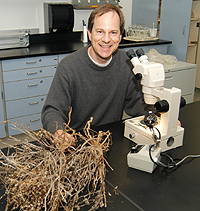| 
Getting to the Root of Desert
Shrub Research
BY DAVE REID
March 4, 2004
 |
| Jochen Schenk, assistant
professor of biological science, received a $320,000 grant
from the Andrew W. Mellon Foundation to study desert shrubs
and how their unique root structure helps them survive.
His research will cover three continents. |
|
 |
Picture a pile of unwrapped drinking straws.
You pick up a handful, put a rubber band around the middle of the
stack and stand the straws up in a container with water in it. The
water will go up each individual straw.
Like a clump of straws, the redundancy of complex
root structures carrying water to a desert shrub is the plant’s
survival strategy, and the subject of a $320,000 Andrew W. Mellon
Foundation research grant awarded to Jochen Schenk, assistant professor
of biological science.
The low, woody plants survive by having several stems,
instead of a single trunk, like a tree. The grant will enable Schenk
to study a variety of shrubs that grow on three continents.
Shrubs are the dominant plant growth in shrublands
and deserts, which cover about 30 percent of global land area. Although
much has been written about the ecological and economic importance,
persistence and growth of such plants, says Schenk, little has been
recorded about the shrubs’ unique growth form in arid and
semi-arid ecosystems.
“These shrubs possess strongly segmented woody
stems and roots, which in many species split apart as the shrubs
mature, often resulting in complete fragmentation of the plants.
Usually the split segments do not spread apart very much and remain
intertwined,” adds Schenk. “Thus, what looks like one
individual shrub to a casual observer is, on close examination,
often revealed to be a clump of separate, but genetically identical,
plants.”
Schenk’s research documenting the redundancy
of root structures in shrubs will take him far from typical areas
for study. With the help of students and colleagues from the University
of Connecticut, he plans to study shrubs growing at the 30-degree
north latitude mark, which passes through Texas, Louisiana and Florida.
After that, Schenk plans to travel to South America
and South Africa to study shrubs at the 30-degree south latitude.
Schenk attributes much of his success in being awarded
research funds to last summer’s grant academy workshop for
junior faculty members conducted by Linda Patton, director of grants
and contracts. “Working with her in polishing the proposal
was very beneficial,” he says.
With South America and South Africa in the offing,
getting to the root of this research project could prove to be a
big adventure.
« back to Research
|